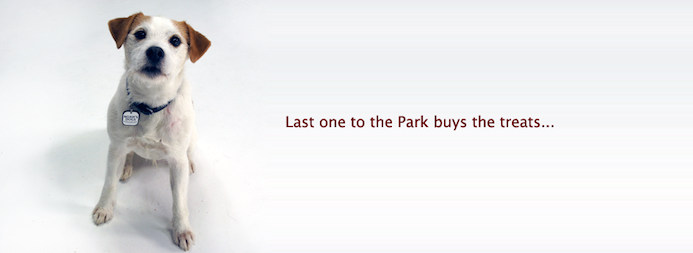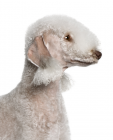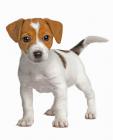Jack Russell Terrier

In my own words
I’m little, happy, not very yappy and extremely lively!”
Don’t let my size fool you, I can be bossy when I need to be! I may be small but I’m as fearless as a lion (even if it does get me into trouble sometimes!) My fearlessness makes me a great guard dog though, you never have to fear when I’m on duty, I certainly make my presence known! Did you know my kind were used for hunting foxes? Imagine that! Little old me, chasing foxes! It just goes to prove that appearances are deceiving, I am definitely not meek and mild for my size!
I love running about though, I have bundles of energy, don’t you? I could run about all day, wouldn’t that be fun! Then we could come home and play a game too, I love playing games. My favourite toy is the tug rope, I bet I can win tug of war with you! Let me get my rope and we’ll see...
My ideal owner(s)
Seasoned dog enthusiasts
Active, sporty types
Families with older children
What they say about me
Athletic
Energetic
Independent
Please read on, to find out more about me, and whether I will be someone you can be happy with for the next 15 years, or even longer!
Is this Jack Russell Terrier for you?
Test your knowledge about the Jack Russell Terrier
Information essential about the Jack Russell Terrier
Kennel Club Group:
Terrier
JRTCA, FCI, UKC, KCGB, NZKC, CET, ANKC, IKC, CKC, NKC, APRI, ACR, DRA, NAPR, FCI, ANKC, IKC, recognise the shorts as Jack Russell Terriers while the UKC recognise the shorts as Russell Terriers. Long legged Jack Russell Terriers are officially called Parsons Russell Terriers. While the Jack Russell Terrier and Russell Terrier are the same breed, the Parsons Russell Terrier are an entirely separate breed.
Size:
Small: Weight 14 – 18 lb (6 – 8 kg)
Height 10 – 15” (25 – 38 cm)
Popularity:
Breed History:
During the mid-1800s this breed was used to hunt foxes and other small game and was developed by English clergyman Rev. John Russell. They were exceeding adept at digging and burrowing into foxholes and dens. The term “Jack Russell Terrier” was coined after Rev. Russell’s death in order to distinguish the small working dogs from the existing “fox terriers,” which were larger and the breed standard was very broad. Even today, Jack Russell Terriers constitute a wide range of different types.
Due to the wide variety of working types, in April 2003 the Jack Russell Terrier Association of America was changed to the Parsons Russell Terrier Association of American. Working types remained as Jack Russells while American show types became known as Parsons Russell Terrier. Some of the Jack Russell's talents include: hunting, tracking, agility, and performing tricks.
Character:
This breed is a cheerful, merry, devoted and loving dog. They are spirit and obedient and fearless. They enjoy games and playing with toys and are generally friendly and kind with children as long as the children do not tease or hit the dog. They are intelligent and can become wilful so they need a firm and confident owner as they need set rules to follow, otherwise they will set their own rules. This breed has a tendency to develop Small Dog Syndrome where they believe they are the pack leader to the humans if not properly trained and controlled. Small Dog Syndrome can lead to behaviour problems including snapping, guarding, separation anxiety and excessive barking. This breed is highly trainable and capable of impressive tricks and are often used on TV or in movies. This breed thrives when given a job to do and as a working dog, has strong hunting instincts. This breed should appear confident, alert, lively and active.
Temperament:
The Jack Russell Terrier is a loving and devoted dog and are highly spirited, lively, amusing and energetic. They get along with considerate, older, well behaved children but are not recommended for children under eight years of age. They do not get along with other pets. Their natural hunting instinct can bring out their aggressive nature but they are highly intelligent and bold. This courage can often lead them into dangerous situations with potentially fatal results.
Conformation:
Conformation:
This breed is sturdy and tough. The body length must be in proportion to the height, and it should present a compact, balanced image, always being in solid, hard condition. The head should be well balanced and in proportion to the body. The skull should be flat, of moderate width at the ears, narrowing to the eyes. There should be a defined stop, which is the transition area from backskull to muzzle,but not overpronounced. The length of the muzzle from the nose to the stop should be slightly shorter than the distance from the stop to the occiput. The nose should be black. The jaw should be powerful and well boned with strongly muscled cheeks. Eyes Should be almond shaped, dark in color and full of life and intelligence. The ears are small "V" shaped drop ears carried forward close to the head and of moderate thickness. Mouth Strong teeth with the top slightly overlapping the lower. Two bites are acceptable; level and scissor - scissor being preferred. The neck is clean and muscular, of good length, gradually widening at the shoulders. The shoulders should be sloping and well laid back, fine at points and clearly cut at the withers. Forelegs should be strong and straight boned with joints in correct alignment. Elbows hanging perpendicular to the body and working free of the sides. The chest should be shallow, narrow and the front legs not too widely apart, giving an athletic, rather than heavily chested appearance. As a guide only, the chest should be small enough to be easily spanned behind the shoulders, by average sized hands, when the terrier is in a fit, working condition. The back should be strong, straight and, in comparison to the height of the terrier, give a balanced image. The loin should be slightly arched. The hindquarters should be strong and muscular, well put together with good angulation and bend of stifle, giving plenty of drive and propulsion. Looking from behind, the hocks must be straight. The feet are round, hard padded, wide, of cat-like appearance, neither turning in nor out. The tail should be set rather high, carried gaily and in proportion to body length, usually about four inches long, providing a good hand-hold.
Coat:
The Jack Russell Terrier has a dense double-coat that comes in three varieties: smooth, rough, and broken. The smooth coat has an outer-coat that is short and stiff. In the rough coat the outer-coat is longer. The broken variety is used to describe both dogs with outer-coats of different lengths or dogs that have longer hair on specific parts of the body.
Colour:
The coat is primarily white (at least 51%) with black, tan or tri-colour markings. Brindle markings are unacceptable
Training:
The Jack Russell Terrier can be determined and wilful and require firm and consistent training as they can be easily distracted. It is important for the owner to assert authority over this breed or they will try and take control themselves. Early socialisation may moderately temper their aggressiveness which stems from their hunting instinct. Obedience training is a must and this breed is talented in hunting, tracking and agility.
Care:
All coat types are easy to groom in this breed. They require regularly brushing and combing with a firm bristle brush and bathe only when necessary. When showing the coat must be stripped. Like the rough coat, a broken coated Jack Russell Terrier needs the coat to be stripped. It is important to keep nails trimmed regularly to prevent problems and this breed can be easily overfed and have a tendency to become overweight so care is needed when feeding.
Health:
The lifespan of a healthy individual is up to 15 years. If you buy from a reputable, responsible breeder, health problems should not occur. This solid breed had relatively few health issues. They can be prone to dislocated kneecaps, inherited eye diseases, deafness and Legg Perthes-a disease of the hip joints in small dog breeds.
Exercise:
This breed will do okay in an apartment provided they are sufficiently exercised. They are very active indoors and do best in an average sized yard. When sufficiently exercised this breed is a pleasant companion but otherwise can become a nuisance. They need a long, daily, brisk walk and love having space to run, hunt and play. They thrive on exercise and require constant stimulation so are not well suited to two career families. This breed can become destructive when bored but enjoy long walks and vigorous play sessions.
You may also like:
Jack Russell Terriers looking for a home in UK »


Jack Russell Terriers and their owners »


If you like Jack Russell Terriers, you may be interested in breeds of the same size »





If you like Jack Russell Terriers, you may like other breeds with similar characteristics »





If you like Jack Russell Terriers, you may be interested in these other terrier dogs »





Advice on choosing your breed »
Find an animal shelter or rescue home where a Jack Russell Terrier is waiting for a new home »
The following grid gives a fast track review which covers all breeds. You can apply it to help you decide if a Jack Russell Terrier is suitable for you, the environment where you live, your personality and your lifestyle. On the grid, 1= strongly disagree, and 5= strongly agree. For example, if you want a playful companion, look down the same list, and you will see that Jack Russells love to fetch and hunt, and score 5. You might like to save or print off this section and keep it for reference while you check some other breeds before making your final choice.
They need a firm, experienced trainer. Jacks who have been allowed to take over can be aggressive with other dogs. Some have killed or been killed in dog fights. Be sure to socialize the Jack. They have strong hunting instincts (stronger than your average terrier) and should not be trusted with other small animals. This hunting dog likes to chase, explore, bark and dig. Only let them off lead if they are well trained or in a safe area. Will get restless and destructive if they do not receive enough exercise and activities to occupy their keen minds. Jack Russells climb, which means they can climb over a fence, they also jump. A Jack Russell that stands 12 inches high can easily jump five feet. They are not the breed for a inexperienced dog owner. The owner needs to be as strong-willed as they are, or this little guy will take over
Add your own ratings on this breed »
|
*PLEASE NOTE: All our breed profiles are general, and all dogs are individuals. Always talk to the breeders and meet the owners you are buying from. Try to meet the dog and its parents if it is a puppy in their home environment.





















